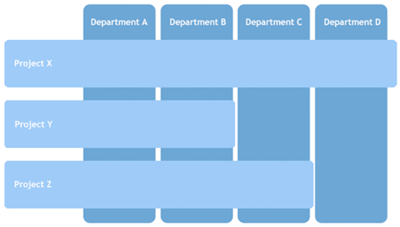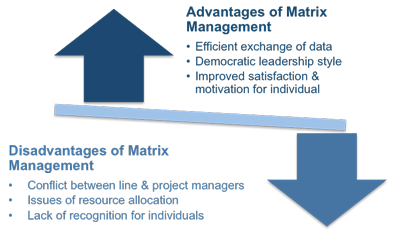Projects in a Matrix-Management Environment
This type of structure can be taken further to give what is known as a pure matrix-management environment.
 |
This is a type of structure in which even though an individual may 'belong to' a particular department, they will be assigned to different projects and report to a project manager while working on that project. Therefore, each individual may have to work under several managers whilst performing their role.
For example,
Someone who is working in Department C and who is assigned part-time to projects X and Z will find themselves reporting to three different managers, all of whom will have some degree of authority over them.
• Their line manager (Dept C)
• Project Manager for project X
• Project Manager for project Z
Matrix management is now fairly common and exists at some level in most large organizations, particularly those that have multiple business units and international operations.
 |
One of the advantages of implementing a matrix structure is that it can lead to a more efficient exchange of information as people from different areas work closely together. This enhances overall productivity because it facilitates quick decision-making. For example,
Individuals from the customer support and production departments may confer with one another to fix problems as soon as they appear. Rather than the production department remaining unaware that there is a problem until it surfaces months later in a management report or memo.
The matrix structure also encourages a democratic leadership style that incorporates the input of team members before managers make decisions. The ability to contribute valuable information before decisions are made leads to employee satisfaction and increased motivation.
A disadvantage of the matrix structure is that it is a recipe for disagreement between the line manager and the project managers. This is because the latter will often try to minimize each department's billing to the project, whereas the departmental managers will usually try to secure as much of the project's budget as possible.
There can also be disagreements about resource allocation and prioritization. This occurs because project managers tend to view their own project as the most important activity and forget that the line manager may have other commitments that his department is expected to meet.
Firstly, line managers have finite resources at their disposal and often have to juggle these in such a way as to 'satisfy most of the demand for most of the time.' In addition, they often have numerous deadlines, relating to both departmental work-in-progress as well as to each project that they are supplying resources to.
Secondly, projects in progress may be subject to changes, following the agreement and commitment of the line resources required. This may result from a failure to achieve the expected progress in any area of work and is likely to have a knock-on effect on the ability of the line manager to supply the resources they are committed to. As a line manager, you may also have to accommodate unexpected resource shortages due to absenteeism and staff turnover.
All of these factors mean that conflict is unavoidable in organizations that are structured in this way and many of these issues described may be complicated further if staff are working on more than one project at a time.
Another feature of the matrix structure is that it can lead to staff members becoming concerned about the extent to which the efforts they expend on project-related work will be recognized and rewarded financially. This problem may be compounded if they feel their project-related work will not be recognized within their own department and no matter how hard they work on the project it will not affect their chances of advancement.
This concern is primarily an issue with staff seconded to projects on a full-time basis as they may feel increasingly isolated and left behind in relation to their long-time colleagues and the departmental practices with which they are familiar. Also, individuals involved with long-term projects may have worries about what happens to them at the end of the project. Their fear could be that their department has learnt to cope without them, or developed new procedures whilst they were assigned to the project.
As a project manager you should ensure each individual's performance is recorded and reported to their line manager so that it can be assessed in their annual appraisal. You can check out the complete range of Project Management PDF eBooks free from this website.
Projects are all about utilizing existing resources and expertise in an efficient and effective way to get things done. The downside of this, from a staff perspective, may be that projects are not seen as training-oriented environments in which to develop personal skills.
The questions raised by the problem of establishing a sound project management structure revolve around the creation of effective reporting lines. There are two organizational extremes that can be adopted:
1. All of the personnel working on the project remain in their normal situation, reporting to their line managers. In this case, the project management staff will need to coordinate the required project work through the line managers.
2. A project team is created and all personnel working on the project are drawn into a project team and report exclusively to the project manager.
In practice a combination of these approaches is often found to be the best solution, and is by far the most common method. However, this organizational framework risks breaking one of the tenets of good management - that of matching responsibility with authority. The project manager will be responsible for performance on the project but may lack sufficient authority where contributors report to their own line managers.
All of these factors mean that unless your organization is completely project focused then you can expect conflict, disagreement, and compromise to be an integral part of organizing a project.
You may also be interested in:
Project Management Principles | Project Management Definition | Project Management Perspectives | Project Organization and Structure | Projects in a Matrix-Management Environment | Project Stakeholders Definition | Project Sponsor Definition | Project Life Cycle Definition | Functional Areas of Project Management.
|
|


